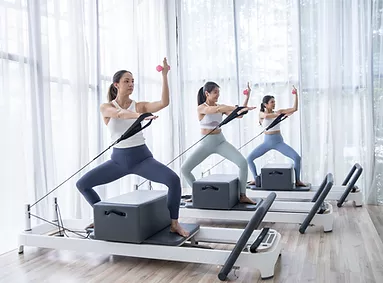
As women, we juggle so many roles. It is so important to fill our own cups and take care of ourselves before we can do a better job at taking care of others. We at Lab are so glad that we have a community of #LabLadies showing up week after week for themselves on the mat, at the barre and on the reformer.
We know exercise can keep us healthy and happy. We wanted to find out more from a medical point of view about the things we should be aware of as women in every stage of our lives. The idea of preventive health screenings might be daunting. What we don’t know wouldn’t harm us right? We get that too. But it is also true that these preventative health screenings help us recognise early stage changes so that we can identify and use available treatments to improve our longevity and quality of life.
We spoke to Dtap clinic on how we can better take care of ourselves. With more information, we can then make #empoweredchoices! We learnt so much about the women’s body from our conversation and hope to share that with you in the form of this article. There is also a link at bottom of this page for you to enjoy discounts to health screenings!
First up, is Cancer. Cancer is an increasingly common disease, one in two women contract cancer at some point in their lives. Possibly considered taboo before, now more than ever, education on health screening for early detection can help save lives. The number of cancer cases and the number of people living with cancer in Singapore has been on an upward trend. According to data from the Singapore Cancer Registry Annual Report 2018, 51.5% of those cases were reported in females.
Breast Cancer
Between 2014-2018, breast cancer accounted for both the largest proportion of new cancer cases and the leading cause of cancer-related deaths amongst females in Singapore, while cervical cancer was ranked tenth in terms of new cancer cases detected and cancer-related deaths. Needless to say, the importance of regular and timely cancer screening to facilitate early detection and treatment is pivotal.
If you’re on the fence about breast cancer screening, there are many risk factors including age and family history. A woman can be considered at high risk of breast cancer if she’s had a personal history of breast cancer, a strong family history of breast cancer, or there was a damage in their genes resulting to an increased risk of breast cancer (e.g. When the Breast Cancer gene is altered, it will not be equipped to fight cancer cells hence leading to a higher risk of breast cancer). High risk women are recommended to get annual screening from the age of 30 years onwards.
For women at average risk for breast cancer (i.e. do not fall into the high risk categories above), guidelines recommend:
Mammogram (X-ray image of breasts)

If you are under 30 years old, you need not feel left out. While mammogram may not be the best option for breast cancer screening, your doctors will most likely recommend breast ultrasound for you.
Exercise can play a big part in reducing your risk! Just 1.25 to 2.5 hours per week of brisk walking has been shown by the Women’s Health Initiative (WHI) to reduce your breast cancer risk by 18%! You can reduce your breast cancer risk even more if you up the exercise to walking 10 hours or more per week.
Beyond the fact that exercise in general can reduce the risk of certain cancers including breast cancer, according to the National Cancer Institute, exercise also lowers the level of certain hormones (including insulin and estrogen) that are associated with the development and progression of breast cancer. Studies say that physical activity after a breast cancer diagnosis has potentially “favorable influence on breast cancer incidence and outcome.”
Cervical Cancer
Cervical cancer is a cancer that affects the lower part of the womb, otherwise known as the cervix. Women who are aged 25 years old and above and who have ever been sexually active are encouraged to go for cervical cancer screening.
Types of cervical cancer screenings recommended for women in different age groups:

For women aged 25-29, the recommended test for cervical cancer screening is a Pap smear once every three years, which is a specialised test that looks for abnormal cells in the cervix.
For women aged 30 and above, the test of choice for cervical cancer screening is a Human Papillomavirus (HPV) test performed every five years, with or without a concomitant Pap smear. HPV is a virus with more than 100 different strains known and is closely associated with the development of cervical cancer and certain other types of cancers (e.g. anal, oral).
This test is important in identifying certain high-risk strains of HPV that may place a patient at an increased risk of developing cervical cancer in the future.
—
You probably heard of Anaemia before but do you really know what Anaemia does to your body? We break it down for you. Anaemia is a condition where the body lacks sufficient red blood cells to transport oxygen to the body’s organs.
Some symptoms include: Fatigue, weakness, dizziness, headaches, pale skin, brittle hair and nails.
There are many possible causes of anaemia. Some of the more common causes of anaemia are iron deficiency and other nutritional deficiencies such as reduced levels of Vitamin B12 or folate. Iron deficiency is the most prevalent nutritional deficiency and the most common cause of anaemia worldwide. Iron deficiency is more commonly seen in women of childbearing age and older individuals.
Risk factors for iron deficiency include: Heavy menstrual bleeding, gastrointestinal bleeding, vegan or vegetarian diet, medical conditions such as coeliac disease that may impair the absorption of iron from the gut, certain medications such as those for acid reflux, pregnancy – a 2019 study found that nearly three-quarters of Singaporean women were iron deficient in the early third trimester of their pregnancy
Individuals who are found to have iron deficiency anaemia can be treated even in the absence of any symptoms to prevent further organ damage and worsening of anaemia. Dietary changes alone are usually insufficient to completely correct iron deficiency even foods high in iron contain only a few milligrams of iron at best. As such, iron replacement is usually required, either in the form of oral supplements or intravenous injections. IV iron infusions are now recommended as first line treatment in most patients with symptomatic, moderate to severe iron deficiency. With successful treatment of iron deficiency, the haemoglobin level – which is the protein in our red blood cells that is responsible for transporting oxygen to our body’s organs and tissues and bringing back carbon dioxide to it – should return to normal levels after about six to eight weeks.
You might be worried to continue exercising if you are suffering from anemia.
When someone is anemic, the body doesn’t have enough healthy red blood cells to carry oxygen to the rest of the body, making it challenging to exercise. However, that’s not to say exercising and anemia can’t go hand in hand. Take these simple precautions to maintain your workout routine when you’re living with anemia.
1. Start off slow. If you have anemia, exercising too intensely too soon might leave you feeling fatigued due to a lack of oxygen circulating through your body. Start your workouts slow and progressively increase the intensity over time. Stick to lower intensity workouts, too, like a yoga class or a walk rather than a run or high-intensity interval training (HIIT) workout.
2. Take breaks often. Always listen to your body. If you feel tired, pause and assess whether or not you can continue. Also, only do what you can. Pushing yourself to your limit is not necessary, so if you feel exhausted, sit down and catch your breath. Waiting it out might be the best option.
3. Shorten your workouts. Any amount of exercise is better than none. The United States Department of Health and Human Services recommends that most healthy adults get at least 150 minutes of moderate activity or 75 minutes of more intense exercise each week. Getting closer to 300 minutes of moderate exercise or 150 minutes of strenuous activity on a weekly basis, however, provides even greater health benefits. But if long or intense workouts seem daunting, just try to sit less and move more. If you have anemia, exercise doesn’t have to be long to be beneficial. Shorter workouts, such as walking around the block or climbing stairs, add up and contribute to your weekly physical activity goal.
4. Timing is key. Work out when you feel the most energized. For some, working out in the morning is when they have the most energy. For others, a late-night gym session is when they hit their peak performance. Sometimes this takes trial and error, but work out when you feel most invigorated.
5. Talk to a healthcare provider. Be sure to talk to your primary care physician to ensure your workout routine is safe, and remember to always stick to the treatment plan already prescribed to you. Because there are both mild and extreme forms of anemia, you may have to change up your routine.
Exercising with anemia is possible as long you don’t overexert yourself. Listen to your body’s needs and act accordingly.
Than you Dr. Jonathan Chong (Dtap) for taking us through!





